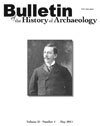Who were the Professional North American Archaeologists of 1900? Clues from the Work of Warren K. Moorehead
DOI:
https://doi.org/10.5334/bha.2112Keywords:
prehistory, collecting,Abstract
It is generally agreed that the period around the end of the nineteenth and beginning of the twentieth centuries was one when the term ‘professional’ could be applied to a significant number of North American archaeologists (Browman 2002b: 514; Kehoe 1999: 5; Kurtz 1979: 13), even though the term itself rarely appears. In June 1900, Warren K. Moorehead, unemployed and living in a cabin in Saranac Lake, New York, recovering from tuberculosis, had just finished a book on Prehistoric Implements (Moorehead 1900). The book might be said to epitomize the transitional character of the period – focused on the collection and naming of artefacts and written with the help of collectors, amateurs, and professionals, by an archaeologist and artefact dealer. The volume also appears to be the first place where the phrase ‘professional archaeologists’ is used.[1] In the preface, Moorehead writes:
The professional archaeologists of the museums will understand that this book is not for them [footnote: There are 27 men who may be considered scientific archaeologists. There are 23 others connected in various capacities with the museums]. I mention it lest some imagine that I am assuming to instruct those who know a great deal more about prehistoric times than I do. It is from the reports and other publications of these 27 authorities that much of the information presented herein has been obtained.
Moorehead clearly had a list. The reason that he had a list is an indication of how central he was in American archaeology at the time. Some background on Moorehead’s career up to this point is useful (and mostly obtained from Moorehead 1902 and Kelly 2000).
Published
Issue
Section
License
Copyright (c) 2011 The Author(s)

This work is licensed under a Creative Commons Attribution 4.0 International License.
Authors who publish with this journal agree to the following terms. If a submission is rejected or withdrawn prior to publication, all rights return to the author(s):
- Authors retain copyright and grant the journal right of first publication with the work simultaneously licensed under a Creative Commons Attribution License that allows others to share the work with an acknowledgement of the work's authorship and initial publication in this journal.
- Authors are able to enter into separate, additional contractual arrangements for the non-exclusive distribution of the journal's published version of the work (e.g., post it to an institutional repository or publish it in a book), with an acknowledgement of its initial publication in this journal.
- Authors are permitted and encouraged to post their work online (e.g., in institutional repositories or on their website) prior to and during the submission process, as it can lead to productive exchanges, as well as earlier and greater citation of published work (See The Effect of Open Access).
Submitting to the journal implicitly confirms that all named authors and rights holders have agreed to the above terms of publication. It is the submitting author's responsibility to ensure all authors and relevant institutional bodies have given their agreement at the point of submission.
Note: some institutions require authors to seek written approval in relation to the terms of publication. Should this be required, authors can request a separate licence agreement document from the editorial team (e.g. authors who are Crown employees).

